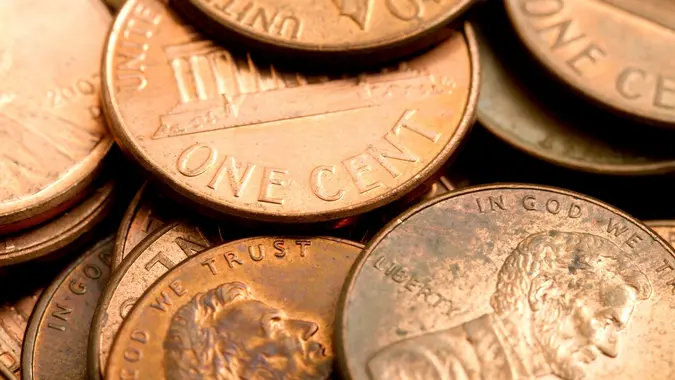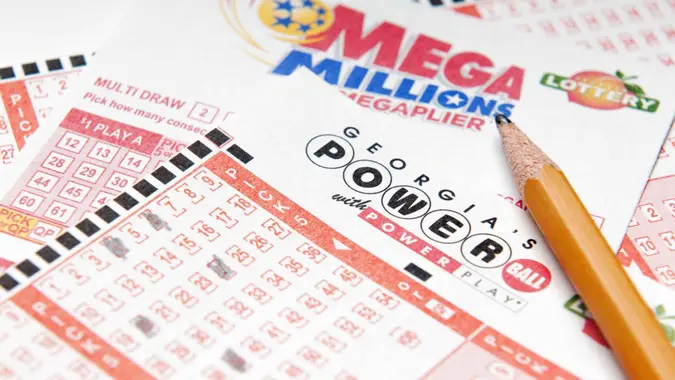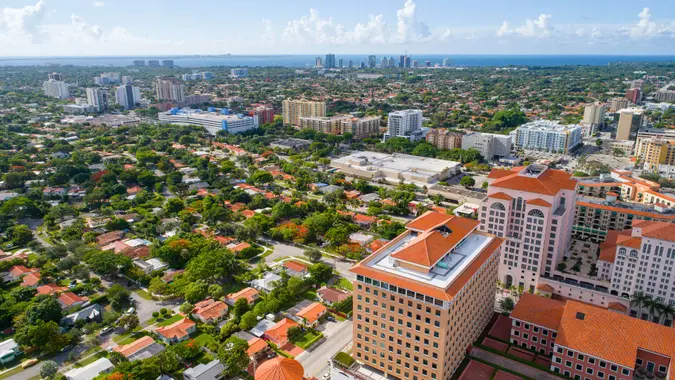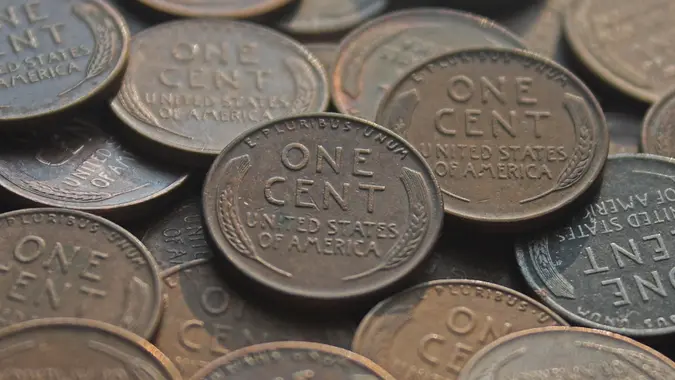How Much Money Is in the World Right Now?

Commitment to Our Readers
GOBankingRates' editorial team is committed to bringing you unbiased reviews and information. We use data-driven methodologies to evaluate financial products and services - our reviews and ratings are not influenced by advertisers. You can read more about our editorial guidelines and our products and services review methodology.

20 Years
Helping You Live Richer

Reviewed
by Experts

Trusted by
Millions of Readers
The total amount of money in the world can be measured and expressed in many different ways, so it’s difficult to give a specific answer.
If you’re curious about the total value of notes and coins in circulation, the Bank for International Settlements estimated it to be $8,275,000,000,000, or $8.28 trillion U.S. dollars, across 20 major countries plus the euro area in 2021, its most recent estimate.
Of course, there are nearly 200 countries in the world, so this is just a rough estimate of the most narrowly defined — and perhaps easiest to quantify — category of money.
How Money Is Categorized
Economists divide money into categories based primarily on how liquid it is, according to the Federal Reserve Bank of Richmond.
The range starts at the narrowest and most liquid with M0 and, in the U.S., goes up to the broadest and least liquid, M3. Each M level includes the levels that precede it, so M3 includes M0, M1 and M2.
The central bank in the U.S. is the Federal Reserve System, which publishes U.S. currency data based on three of the four Ms:
How Money Supply Is Measured
- M0: Referred to as the monetary base, M0 includes all the money in circulation, including money banks hold in reserve. According to the Federal Reserve’s data for September 2024, there was about $2.3 trillion in circulation.
- M1: It includes all the M0 money supply, plus the money held in travelers’ checks, demand deposits, other types of checkable deposits and negotiable orders of withdrawal. As of September 2024, the seasonally adjusted stock of M1 totaled $18.15 trillion.
- M2: It includes all of the currency from the M1 money supply, and expands to include mutual funds, CDs, money market securities and other types of time deposits. The total stock of M2 was $21.22 trillion in September.
- M3: It includes all the elements of M2, plus the money of large institutions. As compared to M1 and M2, M3 assets have the lowest liquidity. The Fed no longer calculates M3.
Gross Domestic Product
Another way to view global wealth is by gross domestic product, or GDP, which is the total value of all the goods and services produced and purchased within a given country over the course of a year or other time period.
While GDP measures a nation’s production and tracks its economy’s growth or contraction, the International Monetary Fund notes that GDP has a number of shortcomings, including its failure to measure residents’ standards of living and well-being. One reason is the disparity in GDP distribution — a country’s residents don’t benefit equally from GDP growth.
Human Development Index
The Human Development Index adds context to the GDP and money supply by measuring countries’ longevity and education as well as their income. According to the United Nations Development Programme, the HDI acknowledges that longevity and education are as important to a country’s development as its economic factors.
Where the economic factor is concerned, the HDI measures gross national income, or GDI, instead of GDP because GNI represents what residents earn rather than the value of what they produce.
In 2023, the global gross national income totaled $105.7 trillion, according to the World Bank Group. But just as GDP fails to reflect disparities in the benefits of production, GNI doesn’t reflect income inequality, which is why it’s important to view the figures in the context of the other factors.
How Much Money Is There Per Person in the World?
Estimates of how much money there is per person in the world vary widely because of the several different ways to measure it.
Using the Federal Reserve’s $2.3 trillion M0 currency figure and a current world population of 8.17 billion, per Worldometer, there’s about $282 per person in the world, on average. Using the M1 figure, the amount is $2,221. Using the M2 figure, the amount per person is $2,597.
However, not all estimates include every country or every person, and the figures vary widely based on whether they represent average or median wealth.
For example, UBS Wealth Management publishes an annual Global Wealth Report. The 2023 report, which is the most recent containing a global net private wealth estimate, put the average figure at $84,718, but it only counted adults, and it only used figures for the 60 countries with the highest total wealth.
In a report on that data, Visual Capitalist also provided the median amount per adult — $8,654.
As with GDP and GNI, global estimates don’t reflect the enormous disparities in wealth from one country to the next, or from one individual to the next within a given country.
FAQ
Here are more answers to questions about money and currency in the world today.- How much physical cash exists in the world?
- The Bank for International Settlements estimates that there are $8,275,000,000,000, or $8.28 trillion U.S. dollars, across 20 major countries plus the euro area in 2021, its most recent estimate.
- What is the difference between money supply and total wealth?
- Money supply refers to cash while wealth include assets that aren't literally money.
- Is cryptocurrency included in the global money count?
- It depends on who is counting. The total market cap of cryptocurrency, as reported by CoinMarketCap, is $3.29 trillion as of May 2025.
Amber Barkley, Elizabeth Constantineau and Daria Uhlig contributed to the reporting for this article.
Our in-house research team and on-site financial experts work together to create content that’s accurate, impartial, and up to date. We fact-check every single statistic, quote and fact using trusted primary resources to make sure the information we provide is correct. You can learn more about GOBankingRates’ processes and standards in our editorial policy.
- CMC Markets. "Top 16 Strongest Currencies in the World."
- Federal Reserve Bank of Richmond. "Money Supply."
- U.S. Federal Reserve System. "Money Stock Measures."
- BIS. "CT2: Banknotes and coins in circulation."
- Statista. "Largest stock exchange operators worldwide as of December 2023, by market capitalization of listed companies."
- Visual Capitalist. "All of the World’s Money and Markets in One Visualization (2022)."
- Reuters. "China FX regulator says CBDC features could improve monetary policy."
- Reuters. "Bank of Japan launches forum with 60 firms on digital yen pilot programme."
- International Monetary Fund. "Gross Domestic Product: An Economy’s All."
- European Central Bank. "Eurosystem proceeds to next phase of digital euro project."
- Human Development Reports. "Human Development Index (HDI)."
- Visual Capitalist. "Visualizing the Top Countries by Wealth per Person."
- Visual Capitalist. "Mapped: The Largest Stock Exchanges in the World."
- CoinMarketCap https://coinmarketcap.com/
 Written by
Written by  Edited by
Edited by 

























